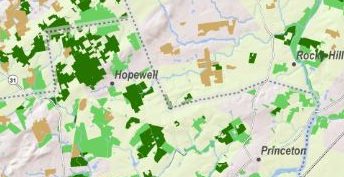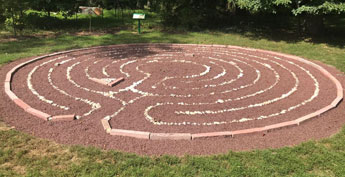Napoleon’s Brother Lived in N.J. Here’s What Happened to the Estate.

Jan. 31, 2021, 5:00 a.m. ET, The New York Times ~
The name Bonaparte brings to mind many locales: Corsica, Paris, Alexandria, Waterloo and, finally, St. Helena.
New Jersey? Not so much.
Napoleon, the French emperor, never stepped foot in the state, but New Jersey was home to another Bonaparte: Napoleon’s older brother, Joseph, who was once the king of Naples and then Spain.
Bonaparte built a sumptuous estate in 1816 called Point Breeze in Bordentown, N.J., just south of Trenton, between the power centers of New York City and Philadelphia. He constructed atop a promontory that allowed him to see any hostile forces and perforated the grounds with tunnels that allowed quick escape, if necessary, to a boat on Crosswicks Creek, and from there to the Delaware River.

“There’s a real opportunity to celebrate the history and at the same time make this very relevant to people today who want to come and walk on the trails, learn about the land and possibly even garden on the property,” said Linda Mead, the president of D&R Greenway, the land trust that helped arrange the sale.
Joseph Bonaparte fled Europe and wound up in Bordentown after Napoleon’s defeat at the Battle of Waterloo in 1815.
Point Breeze included exquisite sculpture gardens, coach trails, brick bridges, stables, a gardener’s house and a lake Bonaparte made by damming a nearby creek.
The centerpiece was a palatial, three-story, nearly 38,000-square-foot mansion that contained an extensive wine cellar, an extravagant art collection and a colossal library.
After Bonaparte left New Jersey for good in 1839, the estate passed to a series of owners, many of them not overly concerned with its preservation. The only surviving remnants include the gardener’s house, a bridge, old foundations and mounds of buried brick that had once been the tunnels.
The site will soon be opened to the public and the contemporary buildings on the property, erected by other owners, will become Bordentown’s new city hall and police station. The gardener’s house will be a museum dedicated to the estate’s history.

The deal closed on Dec. 18 and cost $4.6 million, the bulk of which came from the state.
Many of the artifacts that will be displayed in the museum will come from the private collection of Peter Tucci, 59, a lawyer from New Hope, Pa., about a half-hour from Bordentown. He has spent years, and by his count more than $200,000, collecting Bonaparte memorabilia.
Mr. Tucci said he became fascinated by the regal resident about 25 years ago when he stumbled on a magazine article about him.
“That little article’s cost me a lot of money,” Mr. Tucci said. “But it’s led me down a lot of interesting paths.”
During his research, he became acquainted with the handful of priests living at Point Breeze, which was being used as a residence for semiretired clergymen.
Mr. Tucci learned that Divine Word was considering selling the property, and in late 2018 discussed the possibility of buying it with Ms. Mead and D&R Greenway, which has preserved nearly 21,200 acres, mostly in New Jersey. After getting approval from the D&R Greenway board, Ms. Mead asked city and state officials if they were interested in the purchase.
Ms. Mead said the priests wanted the deal to proceed quickly, but Divine Word could not move forward without approval from the society’s leadership in Rome. Other potential buyers were also eyeing the site.
“There were literally developers breathing down our neck,” Ms. Mead said.
James E. Lynch Jr., mayor of Bordentown, a community of about 4,000 people spread over one square mile, said his constituents were thrilled that Point Breeze would become a park instead of a housing development or a storage warehouse, which some developers had been interested in building.

“Divine Word could have sold this property to other entities for a significant amount of money more, and they chose to leave this property the way they found it,” Mr. Lynch said.
Father Quang Duc Dinh, provincial superior of the Society of the Divine Word’s Chicago Province, said the society decided to sell Point Breeze after determining that maintaining the property for the few remaining clerics did not make financial sense. The future use of the land was a major factor in the sale to the partnership
“We chose to protect the historical and open nature of this beautiful property,” he said in an email.
Many local residents know Bonaparte’s story, and Mr. Tucci said he hoped that opening the estate would disseminate its history more widely.
In Bonaparte’s day, Point Breeze saw many prominent visitors, including John Quincy Adams, Daniel Webster, Henry Clay and the Marquis de Lafayette. Its library contained 8,000 volumes, more than the Library of Congress at the time, and Bonaparte employed hundreds of people.
In a biography of Bonaparte, Patricia Tyson Stroud said a visitor in 1819 observed that “only the White House in Washington surpassed it.”
Bonaparte’s mansion caught fire the night of Jan. 4, 1820, as he was returning from a visit to New York. Historians are not certain of the cause, but Ms. Stroud wrote that it might have been either an accident, perhaps a guest’s fire left smoldering in a hearth, or arson, possibly an attempt to destroy copies of some of Napoleon’s correspondence.
Bonaparte rushed back to see his roof collapsing as neighbors rushed into the burning building to save as many of his possessions as they could carry, including paintings by Jacques-Louis David, Rembrandt and Goya, as well as the Spanish crown jewels.
Bonaparte had to restrain some of his neighbors from going back into the house, according to Ms. Stroud’s account. His neighbors presented him with all of his surviving belongings — nothing had been stolen.
Bonaparte wrote a letter to a local official thanking the townspeople for their efforts. The letter was translated from French and widely published in newspapers.
“This event has proved to me how much the inhabitants of Bordentown appreciate the interests I have always felt for them; and shows that men, in general, are good,” the letter read in part. After the fire, Bonaparte built a second mansion, even grander than the first.
In 1832 he moved to London, returning to Point Breeze intermittently before moving to Europe for good in 1839. He died in Florence in 1844.
The second mansion no longer stands because Henry Beckett, a British diplomat, razed it after buying the property in 1850. He replaced it with an Italianate villa, which was destroyed by a fire in 1983.
A reporter led around the grounds recently by Ms. Mead, Mr. Tucci and Mr. Lynch, discovered a palimpsest of different ages — “layers upon layers” of history, Ms. Mead said, dating to the Lenape, a Native American tribe that inhabited the area long before Europeans arrived.

Not far from where Bonaparte’s first mansion stood is the site of the future city hall and police station. Down a steep embankment is an entrance, choked by leaves and sticks, to a surviving tunnel, a brick structure with a surprisingly high ceiling.
Rising out of the woods is a storybook bridge over a dry creek bed, the brick furred with lichen, moss and cobwebs.
At the gardener’s house, near the property’s entrance, period furniture rested on contemporary carpet. Ms. Mead and Mr. Tucci discussed what the first exhibit might contain.
Ms. Mead said that she hoped to open Point Breeze to the public by this fall. Some potential visitors had already expressed interest through donations to refurbish the property, Ms. Mead said, including an anonymous benefactor from France who contributed $10,000.
“I think people will come from all over to visit,” Ms. Mead said, in no small part because “there are so many stories to be told.”
Daniel E. Slotnik is a general assignment reporter on the Metro desk and a 2020 New York Times reporting fellow.
He wrote for the obituaries desk for nearly a decade, chronicling the lives of hundreds of fascinating people, contributing to the Overlooked series and serving as the lead writer for Not Forgotten. He has also covered higher education and breaking news and written for many sections of the paper. @DSlotnik
BACKGROUND:
D&R Greenway Land Trust, an accredited nonprofit, has saved over 21,000 acres of New Jersey land since its founding in 1989. By preserving land for life and creating public trails, it gives everyone the opportunity to enjoy the great outdoors. The land trust’s preserved farms and community gardens provide local organic food for our neighbors—including those most in need. Through strategic land conservation and stewardship, D&R Greenway combats climate change, protects birds and wildlife, and ensures clean drinking water for future generations. D&R Greenway’s mission is centered in connecting land with people from all walks of life.
D&R Greenway’s Johnson Education Center, home to its art galleries in Princeton, is currently closed to ensure health and safety due to COVID, although its outdoor trails and labyrinth are open. Visit our Facebook and Instagram pages and www.drgreenway.org to learn about the organization’s latest news and virtual programs. D&R Greenway Land Trust, One Preservation Place, Princeton NJ 08540. Best way to reach D&R Greenway Staff during the COVID pandemic is by info e-mail, available on their website.






















